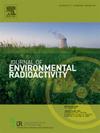Transfer of 14C from naturally depleted peat to freshwater benthic invertebrates in a controlled laboratory system
IF 2.1
3区 环境科学与生态学
Q3 ENVIRONMENTAL SCIENCES
引用次数: 0
Abstract
Radiocarbon (14C) is a key radionuclide in radioactive waste management due to its long half-life and potential integration into the global carbon cycle. However, its incorporation into freshwater organisms remains poorly understood. This study investigated the transfer of 14C into two benthic invertebrates, Lumbriculus variegatus and Chironomus riparius, in a controlled experimental system. Naturally 14C depleted peat was used as the primary carbon source and substrate for the organisms, enabling clear source tracing without artificial labeling but represented a simplified scenario compared to natural sediments with higher nutritional quality. An isotope mixing model based on the natural 14C abundance partitioned C sources between peat and dietary inputs (fish food and unbleached strips of paper towel). Results showed significantly higher peat-derived C contribution in C. riparius (40 %) than in L. variegatus (<3 %), likely due to more active substrate-feeding of recalcitrant peat during early instars. In contrast, L. variegatus with slower C turnover likely relied on previous dietary C (fish food and unbleached strips of paper towel) or assimilation from fish food in the feeding group rather than feeding on recalcitrant peat with larger particles. Survival rates differed, with lower chironomid survival possibly influenced by a combination of peat characteristics (recalcitrant and acidic), food distribution, and sensitivity of early instars. While these findings provide baseline data for biosphere models of 14C transfer, the use of peat and simplified conditions limits direct extrapolation to natural systems. Further studies with representative sediments and ecological complexity are needed to improve risk assessments.

在受控实验室系统中,14C从自然枯竭的泥炭向淡水底栖无脊椎动物的转移
放射性碳(14C)由于其较长的半衰期和可能融入全球碳循环而成为放射性废物管理中的关键放射性核素。然而,人们对其与淡水生物的结合仍然知之甚少。本研究在对照实验系统中,研究了14C在两种底栖无脊椎动物——杂交虫(Lumbriculus variegatus)和Chironomus riparius体内的转移。天然的14C枯竭泥炭被用作生物的主要碳源和基质,可以在没有人工标记的情况下清晰地追踪来源,但与具有更高营养质量的天然沉积物相比,它代表了一个简化的场景。基于天然14C丰度的同位素混合模型划分了泥炭和膳食输入(鱼食和未漂白的纸巾条)之间的碳源。结果显示,河滨草的泥炭源碳贡献(40%)明显高于异叶草(3%),这可能是由于在早期阶段,对顽固性泥炭的取食更活跃。相比之下,碳周转较慢的l.s variegatus可能依赖于先前的膳食C(鱼食和未漂白的纸巾条)或喂食组从鱼食中吸收的C,而不是以颗粒较大的顽固泥炭为食。存活率不同,较低的摇尾虫存活率可能受到泥炭特征(顽固和酸性)、食物分布和早期敏感性的综合影响。虽然这些发现为14C转移的生物圈模型提供了基线数据,但泥炭的使用和简化的条件限制了对自然系统的直接外推。需要进一步研究具有代表性的沉积物和生态复杂性,以改进风险评估。
本文章由计算机程序翻译,如有差异,请以英文原文为准。
求助全文
约1分钟内获得全文
求助全文
来源期刊

Journal of environmental radioactivity
环境科学-环境科学
CiteScore
4.70
自引率
13.00%
发文量
209
审稿时长
73 days
期刊介绍:
The Journal of Environmental Radioactivity provides a coherent international forum for publication of original research or review papers on any aspect of the occurrence of radioactivity in natural systems.
Relevant subject areas range from applications of environmental radionuclides as mechanistic or timescale tracers of natural processes to assessments of the radioecological or radiological effects of ambient radioactivity. Papers deal with naturally occurring nuclides or with those created and released by man through nuclear weapons manufacture and testing, energy production, fuel-cycle technology, etc. Reports on radioactivity in the oceans, sediments, rivers, lakes, groundwaters, soils, atmosphere and all divisions of the biosphere are welcomed, but these should not simply be of a monitoring nature unless the data are particularly innovative.
 求助内容:
求助内容: 应助结果提醒方式:
应助结果提醒方式:


